2023 note. I’ve published a two-year follow up to this experiment: Digital Minimalism: Two years on.
In November 2020 I started reading Cal Newport’s Digital Minimalism: Choosing a Focused Life in a Noisy World. Newport’s compelling writing style alongside the logic of his argument quickly moved me into action and I decided to embark on what he calls a 30-day Digital Declutter.
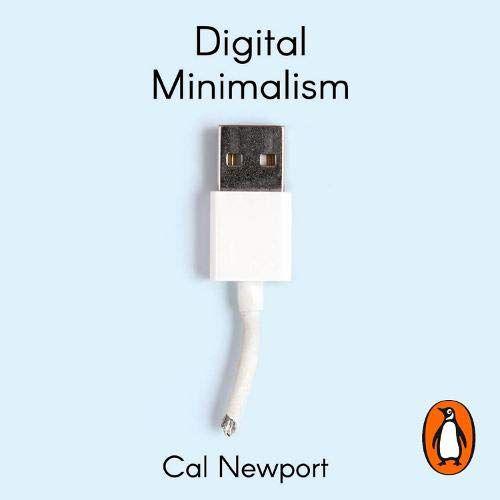
The philosophy of digital minimalism is not simply to rid ourselves of technology but to be clear on what we use and why, so that we can free ourselves of the compulsive use that apps are so effective at fostering. This is not a case of simply removing a few apps, but instead:
a full-fledged philosophy of technology use, rooted in your deep values, that provides clear answers to the questions of what tools you should use and how you should use them and, equally important, enables you to confidently ignore everything else… new technology, when used with care and intention, creates a better life than either Luddism or mindless adoption.
In this post I’m going to share:
- Some of my notes from the 30 days
- The simple changes that made the biggest differences
- What I’ll keep going forward
- Where things didn’t go so well
p.s. After this, check out my 2 year review of Digital Minimalism.
Getting started
I already felt reasonably on top of my technology use. Working in a tech startup means I’m already wired into a hundred services, and this requires the culling of apps and notifications to stay sane and effective. I have also struggled with an anxiety disorder for several years, so I know that when I get overwhelmed with digital signals it hurts me more than the average person. Because of this, I was already quite protective over what I allowed into my attention.
Here are some of the things I’d already implemented:
- No Facebook app on my phone.
- No Slack notifications on my phone.
- No email push notifications on laptop or phone. I check my email when I sit down to work. I still have Gmail on my phone for when I’m out without my laptop but I have to open the app to see my emails.
Remaining problems
So what wasn’t working? I still felt like I was wasting a lot of time on Instagram stories: whether home decor updates from a trail runner on the other side of the planet, or the political rants of the sister of someone I went to school with. I was binging a lot of TV after work and feeling less happy for it. I was also constantly carrying my phone around and this had begun to annoy me more than usual. Finally, I had a growing sense that my Apple Watch was causing me more stress than benefit. There are lots of things I care about, and these habits were stealing hours from these pursuits each day. I wanted to reset my screen time.
Two other big factors were going to make changes harder: living alone after the end of a long-term relationship, and a new national lockdown in the UK, due to Covid-19 (this was national lockdown number 2). These were not ideal circumstances but if the changes could improve my well-being generally, then I assumed they might give me more space to find my peace.
The new rules
Having read through the first few chapters of Digital Minimalism, I had a good sense of what I wanted to start with:
- I removed Instagram and Twitter from my phone.
- I set up BlockSite on my main laptop and blocked Twitter, Instagram and Facebook. I would still use Twitter to tweet new blogs once a week, but not browse any feeds.
- I set up Tempo again to improve the way I processed email. This is a wonderful email app that discourages constant inbox checking and provides better flows for sorting and actioning email. I’d used the first version, but some updates confused me and somehow I ended back with my two pinned Gmail tabs in Chrome (personal and work email) which lead to endless inbox scanning.
- I tried to only open WhatsApp to reply to messages and I stopped having WhatsApp desktop permanently open on my laptop. I would still open it to write responses, as I find that much more enjoyable from a laptop keyboard.
- I got my news from the daily Evening Blend emails via the Spectator, which I could read in 30 seconds and then delete.
- I only opened Strava for uploads once a day after my workout.
- I limited TV. I still allowed it, but no binge-watching. Planning to watch one thing (e.g. the Bake Off final) is kosher. Just turn the TV off after.
- I started recording work and personal todos on a paper pad each day. I regularly default to this manual workflow when I get fed up other note-taking/todo apps.
- I took off my Apple Watch and started wearing a standard watch. I went back to recording workouts on my trusty Garmin 935, and not wearing it the rest of the day.
- There is one area of “digital activities” that Cal Newport does not mention in his book because he is a gentleman and a scholar, and even though I am equally upstanding and would never look at online pornography let’s hypothetically assume I also stopped looking at that too.
- I also made use of the new iOS widgets to clean my home screen of anything non-essential:
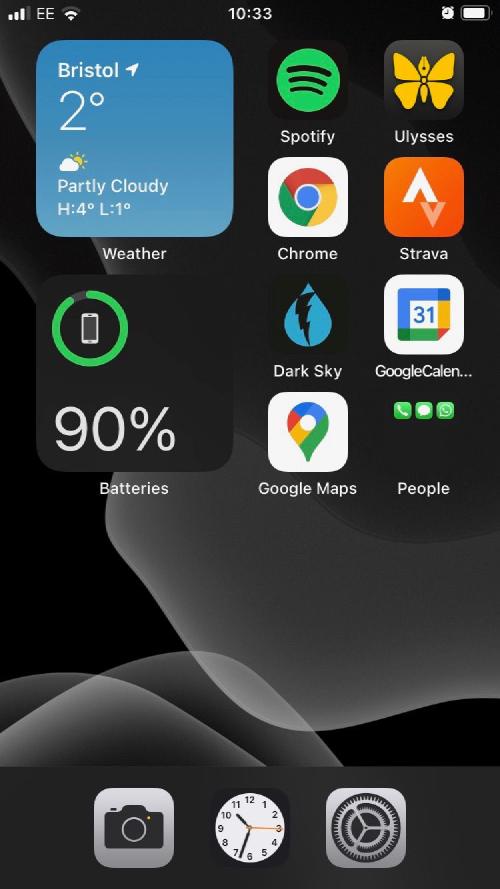
I grouped all incoming communication (phone, texts and WhatsApp) into one group—People—so that one red badge tells me all I need to know. I’d already disabled badges for all other apps. Putting these apps into a group also means they’re an extra click away from the home screen.
What I did more of
Minimalism isn’t just about getting rid of things—you have to double-down on the things that are truly fulfilling otherwise it will just feel like an exercise in subtraction:
If you begin decluttering the low-value digital distractions from your life before you’ve convincingly filled in the void they were helping you ignore, the experience will be unnecessarily unpleasant at best and a massive failure at worse. The most successful digital minimalists, therefore, tend to start their conversion by renovating what they do with their free time—cultivating high-quality leisure before culling the worst of their digital habits. In fact, many minimalists will describe a phenomenon in which digital habits that they previously felt to be essential to their daily schedule suddenly seemed frivolous once they became more intentional about what they did with their time. When the void is filled, you no longer need distractions to help you avoid it.
With a lockdown in full swing, my possibilities for high-quality leisure were reduced, but there were still plenty of activities that I was excited to return to:
- More reading and writing—my happy place
- More bread baking
- More running
- More meditation
- More dog walks
- Getting on top of home decor and design
The 30 days
Week 1
I felt energised from the beginning and didn’t struggle much in the first week: I was happy to get back to other things I’d been neglecting, rather than lamenting the hole that screen time had left.
I got a lot done around the house. Without a phone constantly filling up my mental quota my focus naturally fell on what was visible and physical. This was satisfying and simple.
Writing random ideas on paper throughout the day helped too—if I tried to put them straight into other note-taking apps as usual, I end up seeing other notes and going down a rabbit hole of editing and researching.
Closing Gmail tabs in favour of using Tempo was a big win. I felt the compulsion to tab back to my inboxes in Chrome many times a day—even though they weren’t there—and this was a strange thing to watch my fingers do. I did sometimes need a Gmail tab open when I was waiting for a time-sensitive emails e.g. responses to job offers.
Whilst running I found myself listening to more albums and fiddling less to find the “right” song because I have to get my phone out to do that (vs tweaking via the Apple Watch)
Speaking of which—my watch, my beautiful watch. It tells the time and cares not about the number of people wishing to contact me or my next Zoom call. It accepts me for who I am. There is no red dot of judgement. No incomplete rings of regret. It leaves everything but the time to me, and that was perhaps the biggest relief of the first week.
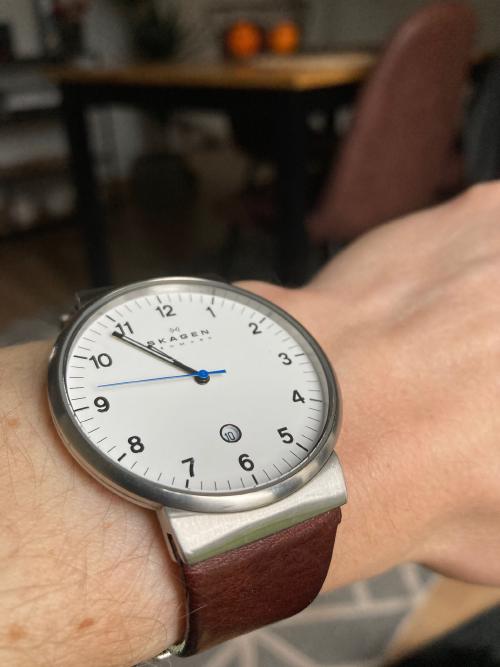
It was also a joy to be able to take the watch off when I want. With the Apple Watch, any time it’s not on my wrist is lost data: fewer steps, fewer calories and missing heart rate data. The Stand ring suffers and a dark blue line of disappointment is there to remind me of my mistake for the next 24 hours. Now, I can take my watch off and the only thing that changes is that I don’t have the time on my wrist. It’s magical.
Later in the week, I noticed I was still carrying my phone around everywhere. It slowly dawned that this was not necessary with so few notifications, but it was one of the more persistent habits.
Even without tech, I still noticed the compulsion to write every thought down and research things immediately. That feels like a big source of anxiety; the fear I might lose things if I don’t record them.
I started eating some meals at the table, with no distractions. This was much harder than I thought it would be, like standing naked on a busy street corner. But when I followed through I enjoyed the meals more and was less likely overeat. I started spontaneously playing with the dog more. I had more energy even when work finished late; getting things done without rushing to the sofa for TV time.
WhatsApp still consumed a lot of my time as I found myself lingering and re-reading messages when I was bored.
At the end of the week, I had my first walk sans phone. I was noticeably in sync with the dog, despite neither of us having slept much. It was fun to be consumed in walking and throwing tennis balls. He also developed a frosty tiara and ice chaps after a sub-zero run which made my day:

This has nothing to do with the declutter. I just wanted you to see this picture. Thank you.
Week 2
The biggest change in week 2 was switching my phone to Do Not Disturb all day, which essentially prevents any notifications, calls or messages coming through. This made a huge difference. It obviates the need for the “quick glance” because it’s always blank:
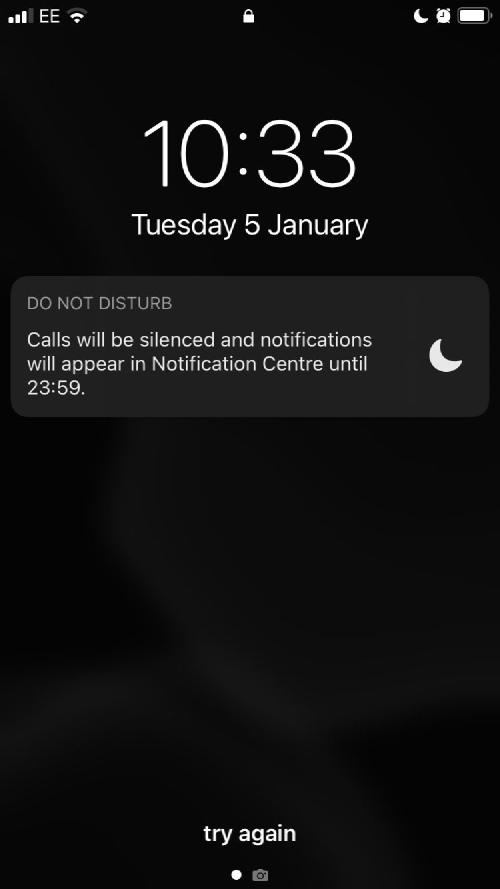
The one thing it’s important to setup are key contacts who’s calls will be let through (e.g. family). Once I had this setup I didn’t worry about missing anything urgent.
This change removed the background anxiety of “waiting” for something to come through; of preparing to be taken somewhere else by a message or request.
This week I also started to notice that removing the quick fix of social media and responding to notifications also resonates into other areas of life. Everything is slower and more intentional. The way I cook, the way I pay attention, the way I talk. It’s cumulative, it’s a mindset.
When your watch auto-unlocks your MacBook and another app is only cmd-tab away and the 30 tabs you need open are all there (somewhere) then you lead with speed and feel frustrated when things aren’t fast. Fortunately, the opposite is also true.
I few days into Do Not Disturb I did struggle with feeling estranged from a phone that wasn’t feeding me things. This didn’t last long: the benefit more than outweighs the cost: the difference between checking in on a conversation (when I chose to) vs a message announcing itself is not subtle. And taking time to check-in is fun! I began to notice the joy of taking time to engage in one conversation—without interruption—even if over text.
I went for a long walk without an audiobook: saying hi to everyone, hearing the changes in the volume of the running river. Colours, texture, fog, sunlight, birds, squirrels. On this particular day, it felt like a real gift.
With more time I also found myself reaching out to friends to schedule a proper (Zoom) catchups vs just sending emails back and forth.
Week 3
I didn’t mention it already, but from day one I listened to a ton of radio, specifically Radio 6. They have some great DJs and play a lot of diverse music. Radio seems much less disruptive than TV. After having the radio on for a few hours, I don’t feel like I’m emerging from a coma, as I do after 2 hours of TV. I came to appreciate the radio even more than before for that reason: a less draining way of remedying loneliness.
I noticed that I’m more aware of adverts and other things derailing me from what I’m doing because my daily journeys through the internet are more focused on one thing. Almost. I looked up DIY coffee table designs and ending up browsing durable waterproof walking boots.
When real-life meetups are your primary source of interaction, you value them a lot more. The delight of bumping into people on walks and catching up.
When I wanted an ongoing WhatsApp convo, I used the Desktop app on my laptop to get notifications there. e.g. watching sports and messaging family. This is a great use of the Desktop app without compromising on phone settings.
Leaving the house without your phone is bliss. I feel like I’m leaving the house naked… and I love it. Besides the size and weight of the thing, there is also no possibility of interruption during the walk, no last-minute messages to respond to as you leave the house or any temptation to stare at your phone instead of taking in your surroundings.
My work focus improved a lot this week: I felt engaged and responsive on calls, less prone to multitasking, and overall less stressed. After one particularly busy day, I still had the energy to wrap up my tax return and update my blog theme in the evening.
At some point this week I turned Do Not Disturb off for an afternoon to get some important messages. It felt gross to have random dinging noises going off. Why is this happening? After a few hours, I was excited to turn it on again. The signal to noise ratio is low. App idea: I would love an iOS app that maintains Do Not Disturb discipline but allows calls, WhatsApps and texts from one particular person, so I don’t miss time-sensitive messages.
Week 4
One side effect I did not expect: I’m listening to fewer audiobooks. Just like not squeezing a 15-page book summary in when you’re taking a shit, this might strike fear into the hearts of productivity nerds. But I don’t feel like I’m missing out. The mental space is more valuable and cramming information into your brain at every waking moment (even in the service of “education”) is still depriving yourself of solitude. Most of the time, I’m less stressed when running and walking without someone else narrating to me as I’m doing it. It’s now a treat, not a default.
This week was dominated by a freak skin reaction to some ankle strapping I’d been using while running. My ankle doubled in size and it became unbelievably itchy and painful which made sleep (and life) very hard.
I consciously broke TV rules here and binged Scrubs hard, whilst eating ice cream and drinking wine. I was happy to break this rule as I was really suffering, and choosing to break one rule intentionally rather than open the floodgates of digital distraction was a good bargain.
One day this week I found myself 10 minutes in a Twitter hole, with zero awareness of what was happening. I had disabled BlockPage to engage with a work tweet the day before and forgot to re-enable it. This stuff is hard! I find Twitter is the most difficult to use without getting lost in trending topics and tweets from journalists I follow.
With my extra time, I’ve been watching more great documentaries and reading more long-form articles. Two of my favourite examples:
- Totally FKT covers two runners and friends trying to break the Fastest Known Time for the 267 mile Pennine Way.
- The Party That Failed. The experience of a former Chinese government worker who began to question the Party: a modern-day account of how authoritarianism works in practice. (via Benedict Evan’s newsletter)
I’ll say it again: going out without a phone is exquisite. A whole layer of stress is simply not present, to the extent that when I discover my phone in my pocket during a walk, it’s quite annoying.
Reflections
That’s it! I found the 30-day challenge more a relief than a struggle. In fact, I don’t know when the 30 days finished exactly (it was sometime before Christmas), but I haven’t changed anything since.
In my experience, the changes are disorienting at first, and there is this diffuse sense of space that feels slightly unnerving, like you’ve forgotten something important. But as you acclimatise, whole other areas of your life start to (re)open. You get used to the space and start to protect it more fiercely. In that space great things happen!
Beyond the first week, I did not miss social media. At all. I thought I would crave Instagram, but it just uneventfully faded from my awareness, like almost everything else I stopped doing.
The biggest benefits
- A sense of mental clarity and space that echoed into pretty much everything I did. My focus was much better without being peppered by notifications, adverts and the polarised political clusterfuck of social media.
- I wrote a lot, including this blog and most of a 10,000-word guide to Vipassana.
- I got my new house into a much better place: tidier, prettier and better laid out.
- I had an increased appreciation of connecting properly with friends. In these times, that means Zoom. I don’t like using Zoom so much—I get enough of it with work—but it’s much more fulfilling than email. I connected with 4 friends I haven’t properly spoken too for a long time and loved the conversations.
- I finally bought an Amazon Echo. I listened to the radio more than ever during these 30 days. I used to play radio via my laptop or iPad, linked to a Bluetooth speaker. Being able to start and control the radio without opening any devices was enough for me to pay up and the sound is great. It also helps with setting timers for cooking and meditation. Voice-activated technology is a big win for the digital minimalist: you cannot browse or scroll an Echo. You need some intent before you initiate the conversation and it won’t speak to you otherwise.
- Along with the bread baking, and I also started making home-made pasta which has become a new hobby.
- Finding time to run was a lot easier. Weekends felt refreshingly open, as they should be.
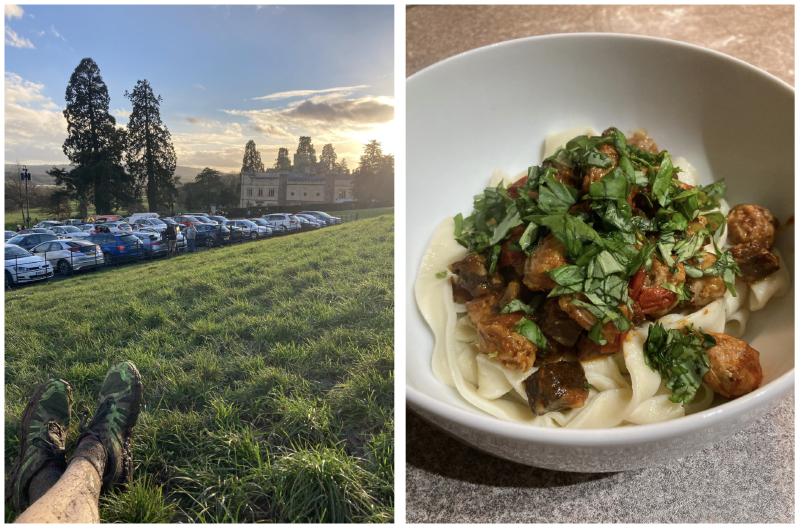
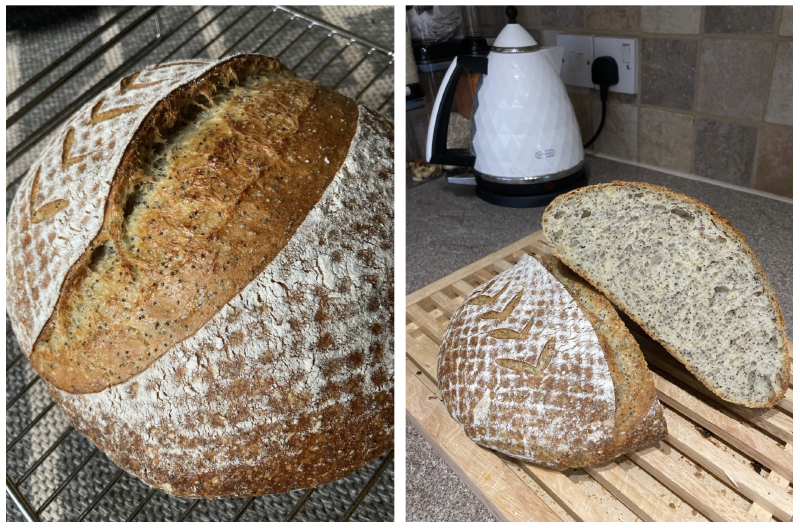
What I’ll keep
- Do not disturb. This was the one change with the biggest impact and it shut down 100 smaller decisions each day. I’ve left it on, all the time. I disable it manually when I’m waiting for an important message.
- No Apple watch. It’s a beautiful bit of technology, but for now I’ve no interest in putting it back on my wrist.
- No social media at all on my phone.
- The hypothetical abstinence from internet porn, as I imagine 30 days without it would feel really good and remove a pernicious distraction that regularly pulls you away from things that are truly nourishing. Hypothetically.
- Tempo is awesome—give it a try if you struggle with Gmail tabs. It’s beautiful and very well thought-out. The app just moved to a subscription model and I am now a happy paying customer.
Still pondering
- I still spent too much time and money on Amazon and found myself browsing listings as soon as something popped into my head.
- I browsed BBC news a lot when I was bored. I would put limits on news sites too if were to do this again.
- I still find myself carrying my phone around a lot when it isn’t necessary.
- I missed one important WhatsApp conversation (a family Covid scare) but no harm came of it in the end.
What I’ll do more of
- I don’t care about Facebook anymore, and I don’t miss anything important from not looking at it. I’m going to switch the apps that use Facebook login to standard email logins and shut it down.
- I’ll keep Instagram but likely only browse on weekends, from a laptop. This negates most of the downside without having to forsake the whole experience.
- Finding one place for my phone so that I stop carrying it around the house like a child dragging a teddy bear around.
Parting advice
Buy the book and try the declutter for yourself. It’s only 30 days, and you can add anything back that you truly missed.
Start treating digital services as places you visit, not alarm systems that can bellow out whenever they think you need to know something. If you allow apps a private channel into your attention, you will not have the willpower to say no the 60 or 70 times a day they interrupt you. There are only a limited number of times you can say “no” each day. Don’t continue to fight them all: fix the problem at the root.
Some form of regular disconnection has to be part of the solution, even though it sounds anti-tech. If you find yourself playing poker with someone each day and notice them repeatedly cheating you out of money then you can get better at spotting the cheating and maybe change the rules. But at some point, you just have to stop playing.
The younger generations alive today are the first to experiment with this level of subjugation to screens and the early results are not good. Get ahead of the curve, reclaim your mental space, and reconnect with the things you truly care about.
I also published a two-year follow up to this experiment, entitled Digital Minimalism: Two years on.
Get my sharpest ideas, once a week.
I publish every day on fitness, tech, wisdom & learning, drawing on my experience as a founder, coach & meditator. I distill the best insights every Wednesday:
